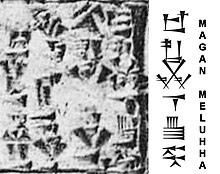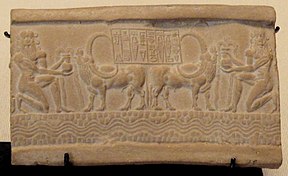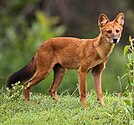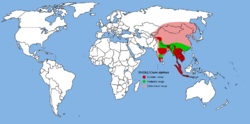Meluhha
𒈨𒈛𒄩𒆠
MeluḫḫaorMelukhkha(Sumerian:𒈨𒈛𒄩𒆠Me-luḫ-ḫaKI) is theSumerianname of a prominent trading partner ofSumerduring theMiddle Bronze Age.Its identification remains an open question, but most scholars associate it with theIndus Valley civilisation.[4]
Etymology[edit]
Asko ParpolaidentifiesProto-Dravidianswith theHarappan Cultureand the Meluhhan people mentioned inSumerianrecords. In his bookDeciphering the Indus Script.Parpola states that theBrahui peopleofPakistanare remnants of theHarappan culture.[5]According to him, the word "Meluhha" derives from the Dravidian wordsmel( "elevated" ) andakam( "place" ). Parpola also relates Meluhha withBeluchistan,which he calls the "Proto-Dravidianhomeland ". He also relates Meluhha with the transient wordMleccha,aVedicword used to mean "barbarian" and used by the incomingAryan speakingpopulation for the native Harappan population.[6][7]
Another piece of possible evidence that points to the people of Meluhha as being Proto-Dravidian is the fact thatsesame oilbelieved to be exported toMesopotamiaby theHarappans,was known asiluinSumerianandeḷḷuinAkkadian.One theory is that these words derive from theDravidianname for sesame (eḷḷoreḷḷu).[8]However,Michael Witzel,who associates IVC with the ancestors ofMundaspeakers, suggests an alternative etymology from thepara-Mundaword for wild sesame:jar-tila.[clarification needed]Munda is anAustroasiatic language[9]
Trade with Sumer[edit]
Sumeriantexts repeatedly refer to three important centers with which they traded:Magan,Dilmun,and Meluhha.[12][13]The Sumerian location of Magan is now accepted to be the area currently encompassing theUnited Arab EmiratesandOman.[14]Dilmun was aPersian Gulfcivilizationwhich traded with Mesopotamian civilizations, the current scholarly consensus is that Dilmun encompassedBahrain,Failaka Islandand the adjacent coast ofEastern Arabiain thePersian Gulf.[15][16]
Inscriptions[edit]

In an inscription,Sargon of Akkad(2334–2279 BCE) referred to ships coming from Meluhha,MaganandDilmun.[19]His grandsonNaram-Sin(2254–2218 BCE) listing the rebel kings to his rule, mentioned "(..)ibra,man of Melukha ".[19]In an inscription,GudeaofLagash(c. 21st century BCE) referred to the Meluhhans who came to Sumer to sell gold dust,carnelian,etc.[19][13]In theGudea cylinders,Gudea mentions that:
"I will spread in the world respect for my Temple, under my name the whole universe will gather in it, and Magan and Meluhha will come down from their mountains to attend."
— Inscription of cylinder A, IX:19[20]
Incylinder B,XIV, he mentions his procurement of "blocks oflapis lazuliand brightcarnelianfrom Meluhha ".[13][21]
Meluhha is also mentioned in mythological legends such asEnki and Ninhursag:
"May the foreign land of Meluhha load precious desirable cornelian, perfectmeswood and beautifulabawood into large ships for you "
— Enki and Ninhursag[22]
There are no known mentions of Meluhha after 1760 BCE.[19]
"Meluhha dog"[edit]
In one of his inscriptions,Ibbi-Sinmentions that he received as a booty fromMarhasia Meluhha red dog:[24][25]
"Ibbi-Sîn, the god of his country, the mighty king, king of Ur and king of the four world quarters, his speckled Meluḫḫa 'dog', fromMarḫašibrought by them as tribute, a replica of it he fashioned, and for his life he dedicated it to him (Nanna). "
— Meluhha dog inscription of Inni-Sin.[26]
The qualifier used to describe the dog is𒁱,which can be read eitherdar"red" as an adjective,[27]orgun3"speckled" as an intransitive verb,[28]and interpretations vary based on these two possible meanings.[29]
It is thought that this "red dog" could be adhole,also called "Asiatic red dog", a type of red-colored dog native to southern and eastern Asia.[23]
Meluhhan trading colony in Sumer[edit]
Towards the end of the Sumerian period, there are numerous mentions in inscriptions of a Meluhha settlement in southern Sumer near the city-state ofGirsu.[30]Most of the references seem to date to theAkkadian Empireand especially theUr IIIperiod.[30]The location of the settlement has been tentatively identified with the city of Guabba.[30]The references to "large boats" in Guabba suggests that it may have functioned as a trading colony which initially had direct contact with Meluhha.[30]
It seems that direct trade with Meluhha subsided during theUr IIIperiod, and was replaced by trade withDilmun,possibly corresponding to the end of urban systems in the Indus Valley around that time.[30]
-
Transcription of tablet BM 17751, with the word "Meluhha" (𒈨𒈛𒄩𒆠).[31]Column II continues Column I on the reverse.
Artifacts[edit]
Several Indus seals withHarappan scripthave been found in Mesopotamia, particularly inUr,BabylonandKish.[34][35][36][37][38]Still, the archeological record for the existence of the trade with the Indus civilization in Mesopotamia is meager. According toAndrew Robinson:
On the other hand, there is not nearly so much incontrovertible evidence for the Indus–Mesopotamia trade as archaeologists might wish. Nissen refers to a ‘meagre archaeological record’. There is only one Indus weight from Ur, for example, out of a total of just fourteen Indus weights found in Mesopotamia, neighbouring Iran (Susa) and the Persian Gulf area. Only some twenty Indus seals have turned up in Mesopotamia since the earliest discoveries, of which nine have been dated to the Akkadian period (2334–2154 BC) and two to the Isin and Larsa dynasties (2000–1800 BC).[39]
Animal figurines[edit]
Various figurines of exotic animals in gold or carnelian are thought to have been imported from Meluhha. Many such statuettes have been found in Mesopotamian excavations.[23]The carnelian statuette of an Asian monkey was found in the excavation of the Acropolis ofSusa,and dated to circa 2340–2100 BCE. It is thought that it may have been imported from India. It is now in the Louvre Museum, reference Sb5884.[33]
Maritime materials trade[edit]

Specific items of high volume trade are timber and specialty wood such as ebony, for which large ships were used. Luxury items also appear, such aslapis lazulimined at a Harappan colony atShortugai(modernBadakhshanin northernAfghanistan).[citation needed]In the 1980s, important archaeological discoveries[which?]were made atRas al-Jinz(Oman), located at the easternmost point of theArabian Peninsula,demonstrating maritime Indus Valley connections with Oman, and the Middle East in general.[45][46][better source needed]
Conflict with the Akkadians and Neo-Sumerians[edit]

According to some accounts of theAkkadiankingRimush,he fought against the troops of Meluhha, in the area ofElam:[49]
"Rimuš, the king of the world, in battle overAbalgamash,king ofParahshum,was victorious. And Zahara[52]andElamand Gupin and Meluḫḫa within Paraḫšum assembled for battle, but he (Rimush) was victorious and struck down 16,212 men and took 4,216 captives. Further, he captured Ehmahsini, King of Elam, and all the nobles of Elam. Further he captured Sidaga'u the general of Paraḫšum and Sargapi, general of Zahara, in between the cities ofAwanandSusa,by the "Middle River". Further a burial mound at the site of the town he heaped up over them. Furthermore, the foundations of Paraḫšum from the country of Elam he tore out, and so Rimuš, king of the world, rules Elam, (as) the god Enlil had shown... "
Gudeatoo, in one of his inscriptions, mentioned his victory over the territories ofMagan,Meluhha,ElamandAmurru.[19]
Identification with the Indus Valley[edit]
Most scholars suggest thatMeluhhawas the Sumerian name for theIndus Valley civilisation.[53]Finnish scholarsAskoandSimo ParpolaidentifyMeluhha(earlier variantMe-lah-ha) from earlier Sumerian documents withDravidianmel akam"high abode" or "high country". Many items of trade such as wood, minerals, and gemstones were indeed extracted from the hilly regions near the Indus settlements. They further claim thatMeluhhais the origin of theSanskritwordmleccha,meaning "barbarian, foreigner".[54]

Early texts, such as the Rimush inscription describing combat against Meluhha troops in the area ofElamcirca 2200 BC, seem to indicate that Meluhha is to the east, suggesting theIndus valley.[49]However, much later texts, such as theRassam cylinderdocumenting the military exploits of KingAssurbanipalofAssyria(668–627 BC), long after the Indus Valley civilization had ceased to exist, seem to imply thatMeluhhais to be found in Africa, in the area of Egypt.[56]
There is sufficient archaeological evidence for the trade between Mesopotamia and the Indus Valley Civilization. Impressions of clay seals from the Indus Valley city ofHarappawere evidently used to seal bundles of merchandise, as clay seal impressions with cord or sack marks on the reverse side testify. A number of these Indus seals have been found atUrand other Mesopotamian sites.[57][58]
The Persian-Gulf style ofcircular stampedrather than rolled seals, also known from Dilmun, that appear atLothal,andFailaka Island(Kuwait), as well as in Mesopotamia, are convincing corroboration of the long-distance sea trade network, which G.L. Possehl has called a "Middle Asian Interaction Sphere".[59]What the commerce consisted of is less sure: timber and precious woods,ivory,lapis lazuli,gold,and luxury goods such ascarnelianand glazed stone beads,pearlsfrom the Persian Gulf, and shell and bone inlays, were among the goods sent to Mesopotamia in exchange forsilver,tin,woolen textiles, perhaps oil and grains and other foods.Copperingots, certainly,bitumen,which occurred naturally in Mesopotamia, may have been exchanged for cotton textiles and chickens, major products of the Indus region that are not native to Mesopotamia—all these have been instanced.
"Meluhha" as Meroe, in the 7th–2nd centuries BCE[edit]

In the Assyrian and Hellenistic eras, cuneiform texts continued to use (or revive) old place names, giving a perhaps artificial sense of continuity between contemporary events and events of the distant past.[60]For example,Mediais referred to as "the land of theGutians",[61]a people who had been prominent around 2000 BC.
Meluhhaalso appears in these texts, in contexts suggesting that "Meluhha" and "Magan" were kingdoms adjacent to Egypt. In theRassam cylinder,Ashurbanipalwrites about his first march against Egypt: "In my first campaign I marched againstMaganandMeluhha,andTaharqa,king ofMusur(Egypt) andKûsu( "Kingdom of Kush",ie Nubia), whomEsarhaddon,king of Assyria, the father who begot me, had defeated, and whose land he brought under his sway. "[62][63]In this context, "Magan" has been interpreted as "Muṣur" (ancient name of Egypt) and "Meluhha" as "Meroe"(capital ofNubia).[64]

In theHellenistic period,the term was used archaically to refer toPtolemaic Egypt,as in an account of a festival celebrating the conclusion of theSixth Syrian War,or in reference to the campaigns ofAntiochus IV Epiphanesin Egypt ("Antiochus the King marched triumphantly through the cities of Meluhha").[65][66]
These references do not necessarily mean that early references toMeluhhaalso referred to Egypt. Direct contacts between Sumer and the Indus Valley had ceased even during theMature Harappanphase when Oman and Bahrain (Magan and Dilmun) became intermediaries. After the sack of Ur by theElamitesand subsequent invasions in Sumer, its trade and contacts shifted west and Meluhha passed almost into mythological memory. The resurfacing of the name could simply reflect cultural memory of a rich and distant land, its use in records ofAchaemenidandSeleucidmilitary expeditions serving to aggrandize those kings. This kind of re-attribution of archaic geographical terms was a regular occurrence during the 1st millennium BCE.[66]
Rulers[edit]
- (..)ibra(between 2300 BC – 2200 BC), possibly contemporary toNaram-Sin of Akkad.
See also[edit]
- Buddhism and the Roman world
- Dilmun
- Economic history of India
- Indus–Mesopotamia relations
- Indo-Roman trade relations
- Magan (civilization)
References[edit]
- ^"Cylinder Seal of Ibni-Sharrum".Louvre Museum.
- ^"Site officiel du musée du Louvre".cartelfr.louvre.fr.
- ^Brown, Brian A.; Feldman, Marian H. (2013).Critical Approaches to Ancient Near Eastern Art.Walter de Gruyter. p. 187.ISBN9781614510352.
- ^McIntosh 2008,p. 46.
- ^Asko Parpola (1994),Deciphering the Indus script,Cambridge University Press
- ^Parpola, Asko; Parpola, Simo (1975),"On the relationship of the Sumerian toponym Meluhha and Sanskrit mleccha",Studia Orientalia,46:205–238
- ^Witzel, Michael(1999),"Substrate Languages in Old Indo-Aryan (Ṛgvedic, Middle and Late Vedic)"(PDF),Electronic Journal of Vedic Studies,vol. 5, no. 1, p. 25, archived fromthe original(PDF)on 2012-02-06,retrieved2018-12-11
- ^Southworth, Franklin (2005).Linguistic Archaeology of South Asia.(See Appendix C.)
- ^McIntosh 2008,p. 354.
- ^Parpola, Asko (2015).The Roots of Hinduism: The Early Aryans and the Indus Civilization.Oxford University Press. p. 353.ISBN9780190226930.
- ^"Meluhha interpreter seal. Site officiel du musée du Louvre".cartelfr.louvre.fr.
- ^Moorey, Peter Roger Stuart (1999).Ancient Mesopotamian Materials and Industries: The Archaeological Evidence.Eisenbrauns. p. 352.ISBN978-1-57506-042-2.
- ^abcMoorey, Peter Roger Stuart (1999).Ancient Mesopotamian Materials and Industries: The Archaeological Evidence.Eisenbrauns. p. 87.ISBN978-1-57506-042-2.
- ^Abed, Ibrahim; Hellyer, Peter (2001).United Arab Emirates: a new perspective.London: Trident Press. p. 40.ISBN978-1900724470.OCLC47140175.
- ^Nayeem, M. A. (1990). "Prehistory and Protohistory of the Arabian Peninsula: Bahrain".M. A. Nayeem.Hyderabad Publishers. p. 32.ISBN9788185492025.
- ^"Sa'ad and Sae'ed Area in Failaka Island".UNESCO.Retrieved21 July2013.
- ^"I will spread in the world respect for my Temple, under my name the whole universe will gather in it, and Magan and Meluhha will come down from their mountains to attend"
"J'étendrai sur le monde le respect de mon temple, sous mon nom l'univers depuis l'horizon s'y rassemblera, et [même les pays lointains] Magan et Meluhha, sortant de leurs montagnes, y descendront"(cylinder A, IX:19)" in"Louvre Museum". - ^"The Electronic Text Corpus of Sumerian Literature".etcsl.orinst.ox.ac.uk.
- ^abcde"MS 2814 - The Schoyen Collection".schoyencollection.
- ^"J'étendrai sur le monde le respect de mon temple, sous mon nom l'univers depuis l'horizon s'y rassemblera, et [même les pays lointains] Magan et Meluhha, sortant de leurs montagnes, y descendront"(cylinder A, IX:19)" in"Louvre Museum".
- ^Moorey, Peter Roger Stuart (1999).Ancient Mesopotamian Materials and Industries: The Archaeological Evidence.Eisenbrauns. p. 97.ISBN978-1-57506-042-2.
- ^Michalowski, Piotr (2011).The correspondance of the Kings of Ur(PDF).p. 257, note 28.
- ^abcMcIntosh 2008,p.187
- ^Gelb, I. J. (1970). "Makkan and Meluḫḫa in Early Mesopotamian Sources".Revue d'Assyriologie et d'Archéologie Orientale.64(1): 4.JSTOR23294921.
- ^Kohl, Philip L. (2015).The Bronze Age Civilization of Central Asia: Recent Soviet Discoveries.Routledge. p. 389.ISBN978-1-317-28225-9.
- ^"CDLI-Archival View".cdli.ucla.edu.
- ^"Sumerian Dictionary" Dar "entry".oracc.iaas.upenn.edu.
- ^"Sumerian Dictionary" Gunu "entry".oracc.iaas.upenn.edu.
- ^Lawler, Andrew (2016).Why Did the Chicken Cross the World?: The Epic Saga of the Bird that Powers Civilization.Simon and Schuster.ISBN978-1-4767-2990-9.
- ^abcdeVermaak, Fanie (2008)."Guabba, the Meluhhan village in Mesopotamia".Journal for Semitics.17/2:454–471.
- ^abcSimo Parpola, Asko Parpola and Robert H. Brunswig, Jr"The Meluḫḫa Village: Evidence of Acculturation of Harappan Traders in Late Third Millennium Mesopotamia?"in Journal of the Economic and Social History of the Orient Vol. 20, No. 2, 1977, p. 136-137
- ^"Collections Online British Museum".britishmuseum.org.
- ^ab"Asian monkey statuette from Susa".
- ^For a full list of discoveries of Indus seals in Mesopotamia, seeReade, Julian (2013).Indian Ocean In Antiquity.Routledge. pp. 148–152.ISBN9781136155314.
- ^For another list of Mesopotamian finds of Indus seals:Possehl, Gregory L. (2002).The Indus Civilization: A Contemporary Perspective.Rowman Altamira. p. 221.ISBN9780759101722.
- ^Gadd, G. J. (1958).Seals of Ancient Indian style found at Ur.
- ^Podany, Amanda H. (2012).Brotherhood of Kings: How International Relations Shaped the Ancient Near East.Oxford University Press. p. 49.ISBN978-0-19-971829-0.
- ^Joan Aruz; Ronald Wallenfels (2003).Art of the First Cities: The Third Millennium B.C. from the Mediterranean to the Indus.Metropolitan Museum of Art. p. 246.ISBN978-1-58839-043-1.
Square-shaped Indus seals of fired steatite have been found at a few sites in Mesopotamia.
- ^Robinson, Andrew (2015),The Indus: Lost Civilizations,London: Reakton Books, p. 93,ISBN9781780235417
- ^McIntosh (2008),p.158-159.
- ^Allchin, Raymond; Allchin, Bridget (29 July 1982).The Rise of Civilization in India and Pakistan.Cambridge University Press. pp. 188–189, listing of figuresp.x.ISBN978-0-521-28550-6.
- ^Kenoyer, Jonathan M.; Heuston, Kimberley Burton (2005).The Ancient South Asian World.Oxford University Press. p. 66.ISBN978-0-19-522243-2.
The molded terra-cotta tablet shows a flat-bottomed Indus boat with a central cabin. Branches tied to the roof may have been used for protection from bad luck, and travelers took a pet bird along to help them guide them to land.
- ^Mathew (2017),p.32.
- ^Robinson, Andrew (2015),The Indus: Lost Civilizations,London: Reakton Books, pp. 89–91,ISBN9781780235417,
To what extent such a reed-made river vessel would have been seaworthy is debatable.... Did the flat-bottomed Indus river boats mutate into the crescent-shaped hull of Heyerdahl's reed boat before taking to the Arabian Sea? Did they reach as far as the coast of East Africa, as the Tigris did? No one knows.
- ^Tosi, Maurizio (1987). "Die Indus-Zivilisation jenseits des indischen Subkontinents". In Ardeleanu-Jansen, Alexandra; Urban, Urban (eds.).Vergessene Städte am Indus, Frühe Kulturen in Pakistan vom 8. bis 2. Jahrtausend(in German). Mainz am Rhein: P. von Zabern. pp. 132–133.ISBN3805309570.OCLC925200287.
- ^Ras Al Jinz Visitor Center Brochure(PDF),Ras Al Jinz Visitor Center, archived fromthe original(PDF)on 10 September 2016
- ^"CDLI-Found Texts".cdli.ucla.edu.
- ^Frayne, Douglas.Sargonic and Gutian Periods.pp. 55–56.
- ^abcdHamblin, William J. (2006).Warfare in the Ancient Near East to 1600 BC: Holy Warriors at the Dawn of History.Routledge. pp. 93–94.ISBN978-1-134-52062-6.
- ^ab"CDLI-Archival View".cdli.ucla.edu.
- ^Frayne, Douglas.Sargonic and Gutian Periods.pp. 57–58.
- ^Bryce, Trevor (2009).The Routledge Handbook of the Peoples and Places of Ancient Western Asia: From the Early Bronze Age to the Fall of the Persian Empire.Taylor & Francis. p. 784.ISBN978-0-415-39485-7.
- ^Possehl, Gregory L.(2002),The Indus Civilization: A Contemporary Perspective,Rowman Altamira, p. 219,ISBN978-0-7591-0172-2
- ^Parpola, Asko; Parpola, Simo (1975). "On the relationship of the Sumerian Toponym Meluhha and Sanskrit Mleccha".Studia Orientalia.46:205–238.
- ^British Museum notice: "Gold and carnelians beads. The two beads etched with patterns in white were probably imported from the Indus Valley. They were made by a technique developed by the Harappan civilization"Photograph of the necklace in question
- ^Hansman, John (1973). "A" Periplus "of Magan and Meluhha".Bulletin of the School of Oriental and African Studies, University of London.36(3): 554–587.doi:10.1017/s0041977x00119858.S2CID140709175.
- ^"urseals".hindunet.org.Archived fromthe originalon 2000-12-11.
- ^John Keay (2000).India: A History.p.16.ISBN9780871138002.
- ^Possehl, G.L. (2007), “The Middle Asian Interaction Sphere”,Expedition49/1
- ^Van De Mieroop, Marc (1997).The Ancient Mesopotamian City.Oxford: Clarendon Press. p. 44.
- ^Sachs & Hunger (1988).Astronomical Diaries & Related Texts from Babylonia, vol.1.Vienna: Verlag der Österreichischen Akademie der Wissenschaften. pp. –330 Obv.18.
- ^Pritchard, James B. (2016).Ancient Near Eastern Texts Relating to the Old Testament with Supplement.Princeton University Press. p. 294.ISBN978-1-4008-8276-2.
- ^Original text and translation:lines 51 and 52 of the Rassam cylinder
- ^History of Assurbanipall, Translated from the Cuneiform Inscriptions by George Smith.Williams and Norgate. 1871. pp. 15 and 48.
- ^Sachs & Hunger (1988).Astronomical Diaries & Related Texts from Babylonia, vol.2.Vienna: Verlag der Österreichischen Akademie der Wissenschaften. pp. –168 A Obv.14–15.
- ^abKosmin, Paul J. (21 April 2014).The Land of the Elephant Kings.Harvard University Press. p. 321.ISBN978-0-674-72882-0.
Bibliography[edit]
- Mathew, K. S. (2017).Shipbuilding, Navigation and the Portuguese in Pre-modern India.Routledge.ISBN978-1-351-58833-1.
- McIntosh, Jane R. (2008).The Ancient Indus Valley: New Perspectives.Santa Barbara, California: ABC-CLIO.ISBN9781576079072.
- Reade, Julian, ed. (1996).The Indian Ocean in Antiquity.London: Kegan Paul Intl.OCLC875303686.
External links[edit]
- Meluhha and Agastya: Alpha and Omega of the Indus Scriptby Iravatham Mahadevan







![A tablet from the period of Shulgi, mentioning the "Meluhha" village in Sumer. British Museum, BM 17751.[31] "Meluhha" (𒈨𒈛𒄩𒆠) actually appears on the beginning of the other side (column II, 1) in the sentence "The granary of the village of Meluhha".[32][31]](https://upload.wikimedia.org/wikipedia/commons/thumb/a/a1/Meluhha_village_tablet_-_BM17751_%28horizontal%29.jpg/200px-Meluhha_village_tablet_-_BM17751_%28horizontal%29.jpg)
![Transcription of tablet BM 17751, with the word "Meluhha" (𒈨𒈛𒄩𒆠).[31] Column II continues Column I on the reverse.](https://upload.wikimedia.org/wikipedia/commons/thumb/7/7d/BM17751_Meluhha.jpg/200px-BM17751_Meluhha.jpg)


